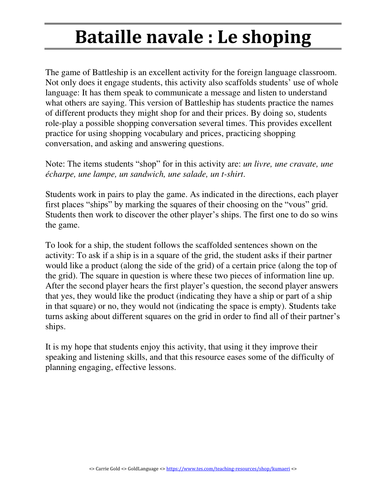
The game of Battleship is an excellent activity for the foreign language classroom. Not only does it engage students, this activity also scaffolds students’ use of whole language: It has them speak to communicate a message and listen to understand what others are saying. This version of Battleship has students practice the names of different products they might shop for and their prices. By doing so, students role-play a possible shopping conversation several times. This provides excellent practice for using shopping vocabulary and prices, practicing shopping conversation, and asking and answering questions.
Note: The items students “shop” for in this activity are: un livre, une cravate, une écharpe, une lampe, un sandwich, une salade, un t-shirt.
Students work in pairs to play the game. As indicated in the directions, each player first places “ships” by marking the squares of their choosing on the “vous” grid. Students then work to discover the other player’s ships. The first one to do so wins the game.
To look for a ship, the student follows the scaffolded sentences shown on the activity: To ask if a ship is in a square of the grid, the student asks if their partner would like a product (along the side of the grid) of a certain price (along the top of the grid). The square in question is where these two pieces of information line up. After the second player hears the first player’s question, the second player answers that yes, they would like the product (indicating they have a ship or part of a ship in that square) or no, they would not (indicating the space is empty). Students take turns asking about different squares on the grid in order to find all of their partner’s ships.
It is my hope that students enjoy this activity, that using it they improve their speaking and listening skills, and that this resource eases some of the difficulty of planning engaging, effective lessons.
Note: The items students “shop” for in this activity are: un livre, une cravate, une écharpe, une lampe, un sandwich, une salade, un t-shirt.
Students work in pairs to play the game. As indicated in the directions, each player first places “ships” by marking the squares of their choosing on the “vous” grid. Students then work to discover the other player’s ships. The first one to do so wins the game.
To look for a ship, the student follows the scaffolded sentences shown on the activity: To ask if a ship is in a square of the grid, the student asks if their partner would like a product (along the side of the grid) of a certain price (along the top of the grid). The square in question is where these two pieces of information line up. After the second player hears the first player’s question, the second player answers that yes, they would like the product (indicating they have a ship or part of a ship in that square) or no, they would not (indicating the space is empty). Students take turns asking about different squares on the grid in order to find all of their partner’s ships.
It is my hope that students enjoy this activity, that using it they improve their speaking and listening skills, and that this resource eases some of the difficulty of planning engaging, effective lessons.
Something went wrong, please try again later.
This resource hasn't been reviewed yet
To ensure quality for our reviews, only customers who have purchased this resource can review it
Report this resourceto let us know if it violates our terms and conditions.
Our customer service team will review your report and will be in touch.
$1.50
